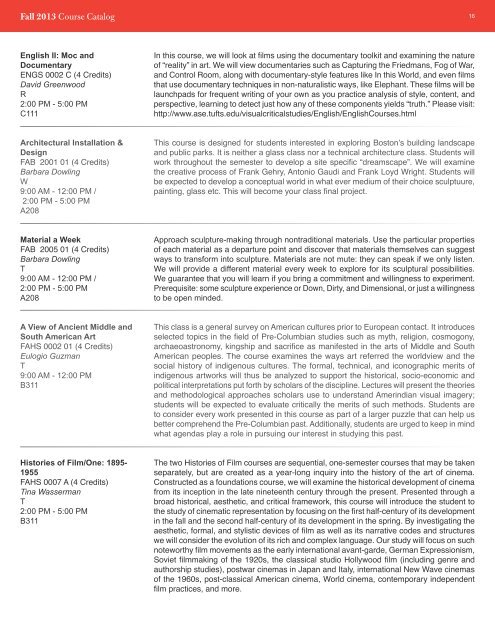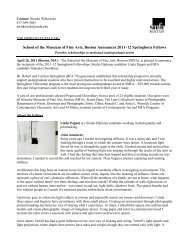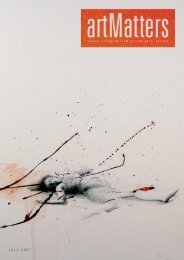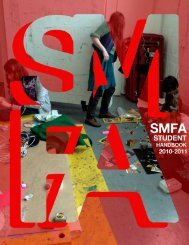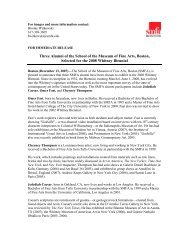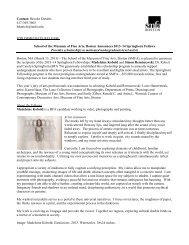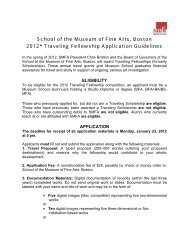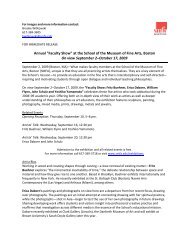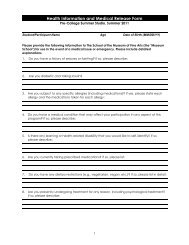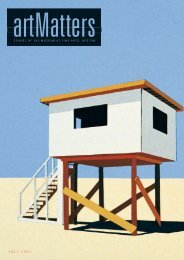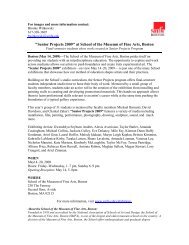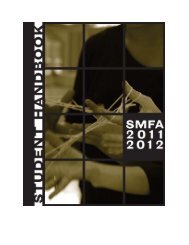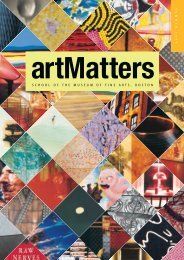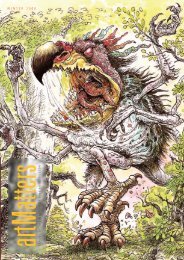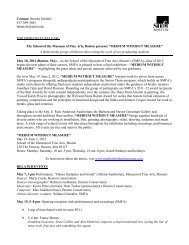Fall 2013 Course Catalog - School of the Museum of Fine Arts
Fall 2013 Course Catalog - School of the Museum of Fine Arts
Fall 2013 Course Catalog - School of the Museum of Fine Arts
You also want an ePaper? Increase the reach of your titles
YUMPU automatically turns print PDFs into web optimized ePapers that Google loves.
<strong>Fall</strong> <strong>2013</strong> <strong>Course</strong> <strong>Catalog</strong><br />
16<br />
English II: Moc and<br />
Documentary<br />
ENGS 0002 C (4 Credits)<br />
David Greenwood<br />
R<br />
2:00 PM - 5:00 PM<br />
C111<br />
In this course, we will look at films using <strong>the</strong> documentary toolkit and examining <strong>the</strong> nature<br />
<strong>of</strong> “reality” in art. We will view documentaries such as Capturing <strong>the</strong> Friedmans, Fog <strong>of</strong> War,<br />
and Control Room, along with documentary-style features like In this World, and even films<br />
that use documentary techniques in non-naturalistic ways, like Elephant. These films will be<br />
launchpads for frequent writing <strong>of</strong> your own as you practice analysis <strong>of</strong> style, content, and<br />
perspective, learning to detect just how any <strong>of</strong> <strong>the</strong>se components yields “truth.” Please visit:<br />
http://www.ase.tufts.edu/visualcriticalstudies/English/English<strong>Course</strong>s.html<br />
Architectural Installation &<br />
Design<br />
FAB 2001 01 (4 Credits)<br />
Barbara Dowling<br />
W<br />
9:00 AM - 12:00 PM /<br />
2:00 PM - 5:00 PM<br />
A208<br />
This course is designed for students interested in exploring Boston’s building landscape<br />
and public parks. It is nei<strong>the</strong>r a glass class nor a technical architecture class. Students will<br />
work throughout <strong>the</strong> semester to develop a site specific “dreamscape”. We will examine<br />
<strong>the</strong> creative process <strong>of</strong> Frank Gehry, Antonio Gaudi and Frank Loyd Wright. Students will<br />
be expected to develop a conceptual world in what ever medium <strong>of</strong> <strong>the</strong>ir choice sculptuure,<br />
painting, glass etc. This will become your class final project.<br />
Material a Week<br />
FAB 2005 01 (4 Credits)<br />
Barbara Dowling<br />
T<br />
9:00 AM - 12:00 PM /<br />
2:00 PM - 5:00 PM<br />
A208<br />
Approach sculpture-making through nontraditional materials. Use <strong>the</strong> particular properties<br />
<strong>of</strong> each material as a departure point and discover that materials <strong>the</strong>mselves can suggest<br />
ways to transform into sculpture. Materials are not mute: <strong>the</strong>y can speak if we only listen.<br />
We will provide a different material every week to explore for its sculptural possibilities.<br />
We guarantee that you will learn if you bring a commitment and willingness to experiment.<br />
Prerequisite: some sculpture experience or Down, Dirty, and Dimensional, or just a willingness<br />
to be open minded.<br />
A View <strong>of</strong> Ancient Middle and<br />
South American Art<br />
FAHS 0002 01 (4 Credits)<br />
Eulogio Guzman<br />
T<br />
9:00 AM - 12:00 PM<br />
B311<br />
This class is a general survey on American cultures prior to European contact. It introduces<br />
selected topics in <strong>the</strong> field <strong>of</strong> Pre-Columbian studies such as myth, religion, cosmogony,<br />
archaeoastronomy, kingship and sacrifice as manifested in <strong>the</strong> arts <strong>of</strong> Middle and South<br />
American peoples. The course examines <strong>the</strong> ways art referred <strong>the</strong> worldview and <strong>the</strong><br />
social history <strong>of</strong> indigenous cultures. The formal, technical, and iconographic merits <strong>of</strong><br />
indigenous artworks will thus be analyzed to support <strong>the</strong> historical, socio-economic and<br />
political interpretations put forth by scholars <strong>of</strong> <strong>the</strong> discipline. Lectures will present <strong>the</strong> <strong>the</strong>ories<br />
and methodological approaches scholars use to understand Amerindian visual imagery;<br />
students will be expected to evaluate critically <strong>the</strong> merits <strong>of</strong> such methods. Students are<br />
to consider every work presented in this course as part <strong>of</strong> a larger puzzle that can help us<br />
better comprehend <strong>the</strong> Pre-Columbian past. Additionally, students are urged to keep in mind<br />
what agendas play a role in pursuing our interest in studying this past.<br />
Histories <strong>of</strong> Film/One: 1895-<br />
1955<br />
FAHS 0007 A (4 Credits)<br />
Tina Wasserman<br />
T<br />
2:00 PM - 5:00 PM<br />
B311<br />
The two Histories <strong>of</strong> Film courses are sequential, one-semester courses that may be taken<br />
separately, but are created as a year-long inquiry into <strong>the</strong> history <strong>of</strong> <strong>the</strong> art <strong>of</strong> cinema.<br />
Constructed as a foundations course, we will examine <strong>the</strong> historical development <strong>of</strong> cinema<br />
from its inception in <strong>the</strong> late nineteenth century through <strong>the</strong> present. Presented through a<br />
broad historical, aes<strong>the</strong>tic, and critical framework, this course will introduce <strong>the</strong> student to<br />
<strong>the</strong> study <strong>of</strong> cinematic representation by focusing on <strong>the</strong> first half-century <strong>of</strong> its development<br />
in <strong>the</strong> fall and <strong>the</strong> second half-century <strong>of</strong> its development in <strong>the</strong> spring. By investigating <strong>the</strong><br />
aes<strong>the</strong>tic, formal, and stylistic devices <strong>of</strong> film as well as its narrative codes and structures<br />
we will consider <strong>the</strong> evolution <strong>of</strong> its rich and complex language. Our study will focus on such<br />
noteworthy film movements as <strong>the</strong> early international avant-garde, German Expressionism,<br />
Soviet filmmaking <strong>of</strong> <strong>the</strong> 1920s, <strong>the</strong> classical studio Hollywood film (including genre and<br />
authorship studies), postwar cinemas in Japan and Italy, international New Wave cinemas<br />
<strong>of</strong> <strong>the</strong> 1960s, post-classical American cinema, World cinema, contemporary independent<br />
film practices, and more.


